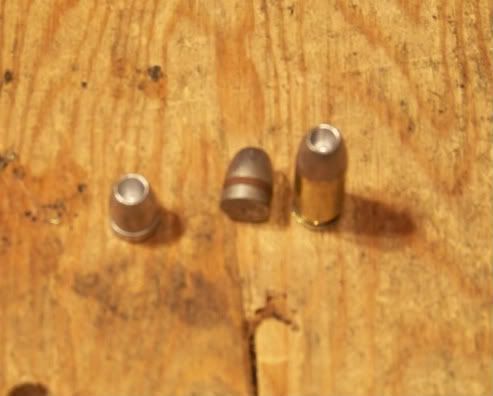My .38 is my "house gun". The load is "designed" as an 850 fps, full caliber flat point that will cause lots of tissue disruption and shock, and little over penetration. The same applies to the 45 ACP, large flat fronted bullet traveling at a moderate speed imparts lots of tissue damage without danger to the neighbors. I have shot quite a few of these reloads and am used to, and comfortable with them and I can usually hit what I point at. My research in gel testing (not mine, but published results) tells me these thoughts are on the right track. Nope, I haven't shot anybody with them, and I haven't shot any cadavers to test the rounds, I just use my own common sense putting the rounds together...
I know this is an old thread, but I post in the interest of not spreading misinformation to those reading this thread (which is comes up readily in a Google search on the topic). If you are loading for "lots of tissue disruption and shock, and little over penetration" the above loads are the exact
opposite of this. The poster is greatly mistaken in his comments, and one can only wonder what ballistic gelatin testing he read that tells him that his "thoughts are on the right track". As the reader can easily find these tests online by googling, allow me to summarize:
The .38 Special 148 grain factory swaged wadcutter at standard factory target velocity has been shown in numerous tests to penetrate 18+ inches of ballistic gelatin, exiting most testing media blocks. Other tests have shown up to 24" of penetration. Loading with a cast DEWC will produce even MORE penetration due to the non-deforming nature of that bullet.
The 200 grain .45 Auto cast SWC at target velocities penetrates as much or more. With either the .38 wadcutter or .45 SWC load, boosting them over a "stiff load" as the poster also stated, would produce penetration of close to 30". In one well-publicized tragedy, a shooter at an IPSC event using a .45 200 SWC loaded to major factor missed his target at a bad angle, the bullet travelling 50 yards and missing the backstop before penetrating through an exterior and interior wall before killing a teenager attending a safety class. There are most certainly NOT limited penetration loads.
As far as "lots of tissue shock", this theory has also been shown by testing to be a false presumption for these types of loads. They do not expand to create a larger wound channel; they remain at bullet diameter. The edges of the lead projectiles are rounded by the firing process - there is no sharp-edged cookie-cutter effect. Nor do these round tumble to create a larger wound channel; they travel straight-line head-on through tissue. While they do make an initial blunt impact, they are more similar in total tissue disruption to round nose bullets, and far behind modern hollowpoint bullets.
While choosing use these WC and SWC types of loads for self-defense based on accuracy, mild recoil, and/or familiarity are valid reasons, they are most definitely
NOT limited penetration rounds, nor do they possess the wounding effect of modern hollowpoint bullets. They are amongst the worst choices for limited penetration in populated areas, apartments, etc. A lightweight HP bullet is far better for the purpose of limited penetration and tissue disruption. If strictly limited penetration is not an issue, then medium or heavy weight jacketed hollow point bullets are still vastly superior in wounding ability to SWC or WC loads.

